
















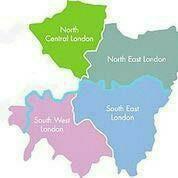







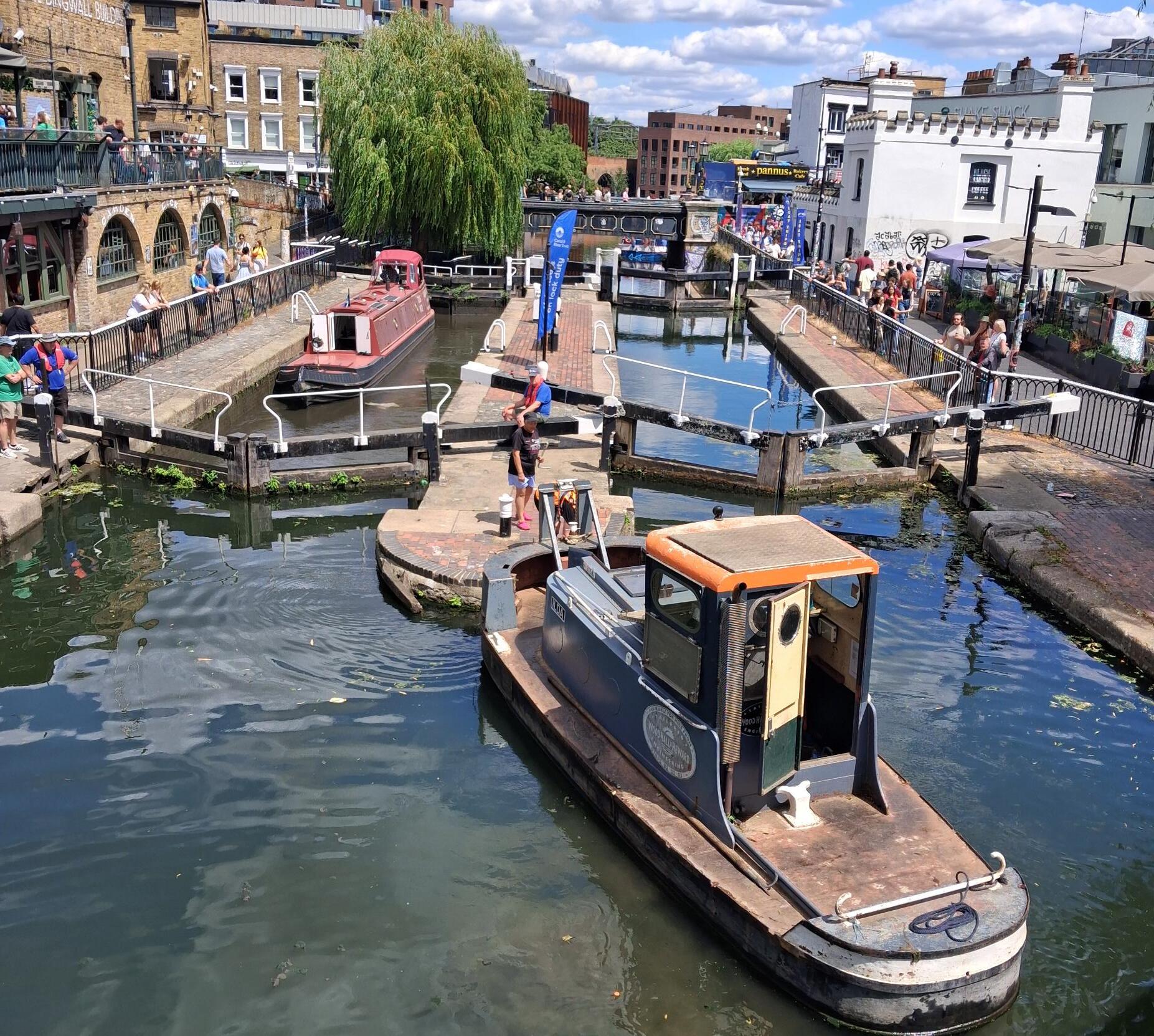
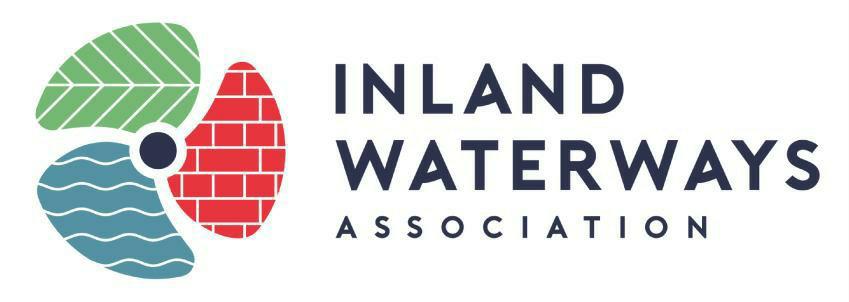
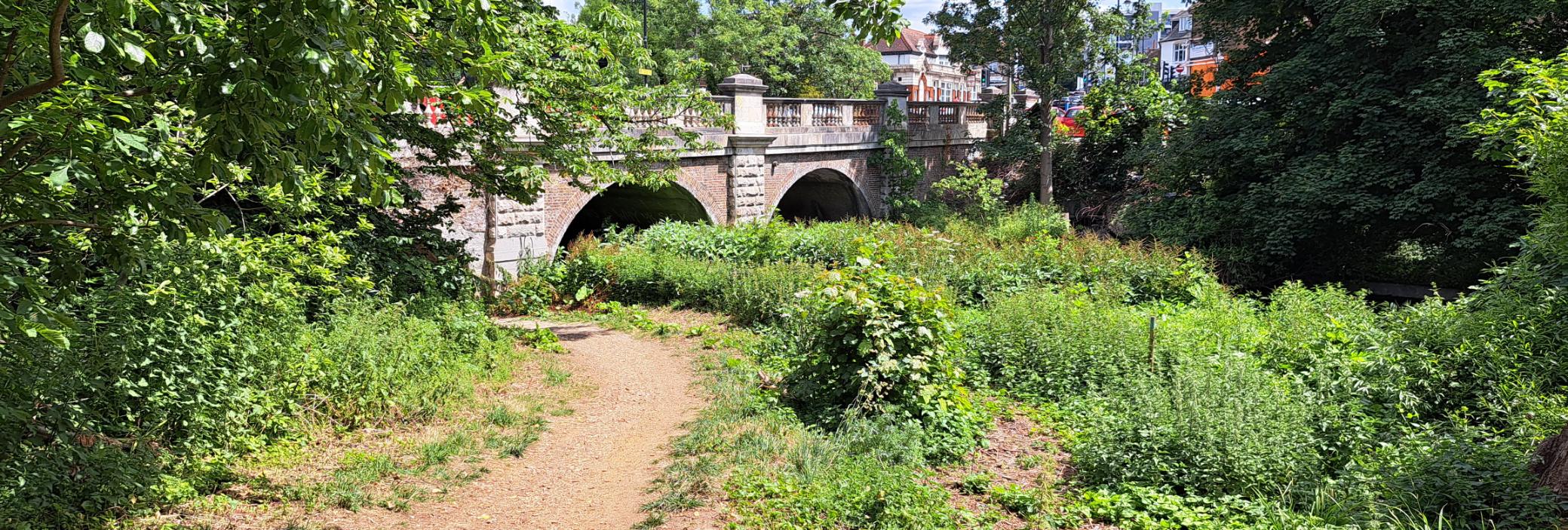





























In early June, an unusual visitor moored in St. Katherine’s Dock.
The Nao Santa Maria is a replica of Columbus’s flagship, the biggest of the three ships which crossed the Atlantic in 1492. It’s a carrack, the fifteenth century predecessor of a galleon, with three masts and a bowsprit, a rounded stern, and four decks.
Built in 2018 by the Nao Victoria Foundation, using Iroko and pine wood, by master shipwrights in Punta Umbria (Spain), it commemorated the 525th anniversary of the Encounter Between Two Worlds. It now sails as a floating museum of its own story and Spanish maritime heritage.
At 93ft (28.3 metres) long, and with a weight of 200 tonnes, it’s not much bigger than the largest sailing barge on the Thames, the S.B. “Will”.
Nevertheless, forty men sailed across the Atlantic in the original Santa Maria. Visitors at St. Katherine’s Dock could imagine the cramped and harsh conditions on board!
This is the first time this replica has visited London, at the beginning of a grand European tour which will take it to ports in Britain, France, the Netherlands, and Spain.
The Santa Maria has previously visited ports across Mexico, the United States, and Europe, before returning to Spain.


Moored just offshore from the Sonesta Posadas del Inca Hotel in Puno in Peru, on Lake Titicaca, lies the British-built, iron-hulled steamship the Yavari. She was built in 1862 for the Peruvian government for use by the Peruvian Navy as a gunboat, passenger, and cargo boat for use on the lake. She looks as good as new by day and is lit up by strings of bulbs at night, providing a magical foreground with the expansive lake and Bolivian hills in the background.
Lake Titicaca is bordered by Peru and Bolivia, covers 8,300 sq. kilometres so can feel more like a sea than a lake with winter waves often making 2m in height. Sitting at 3,810 m above sea level, it is the highest navigable water in the world.
The Yavari was originally 30.5m long and had a 60-horsepower (44.7kW) twocylindersteam engine, which was fuelled with driedllamadung.
Rescued in 1987 from decay in the naval dock in Puno, she has been lovingly restored and is now in fine condition. Most of the ship’s nautical parts (i.e. binnacle, wheel etc.) were recovered, restored and reinstalled. The iron hull was tested ultrasonically for its thickness resulting in two pieces 4” x 4” needing to be replaced. The hull was sandblasted, painted with a coat of anti-corrosive marine paint followed by the black, green, red, and white livery colours of the Peruvian Corporation, owners of the Lake fleet from 1890 until 1972.
She opened as a floating museum registered by the National Institute of Culture in 1998, and you can even stay on her for bed and breakfast sometimes (although currently not available due to ongoing restorations). To go on board, you need to prebook to visit and can do this by making enquiries at the hotel or through local travel representatives. Funds permitting, the intention is to build a permanent jetty (she is currently only reachable by dinghy) and to take passengers on trips around the lake.
Today, she has a Swedish Bolinder hot bulb 4-cylinder semi diesel engine originally installed in 1914. It has been painstakingly cleaned, repaired, and rebuilt. It is now the oldest and largest engine of its kind. It can be fired up and is currently undergoing further restoration so it will be compliant with modern health and safety requirements which will allow the ship to travel once more.
At the same time that the new engine was installed she was also extended in size by 15m to increase cargo capacity.
But how did she get there? She was built at Thames Iron works (where the football team, West Ham United, originated from) on the banks of the River Thames, at the mouth of the River Lea.
She had to be assembled with nuts and bolts at the shipyard, so they could be dismantled, and then reassembled at the lake. She was one of two ships originally and they comprised of 2,766 pieces between them.
On 15th October 1862, the “Mayola”, bearing the two ships and eight British engineers from London, having rounded the Horn, docked at Arica and discharged the packing cases and pieces of the Yavari and her sister ship the Yapura. The Peruvian Navy then faced the daunting task of getting 2,766 pieces and two crankshafts transported to Lake Titicaca.
After a 64Km train journey, to Tacna, the last 350Km had to be completed using pack mules.
The original British contractor got the parts to Tacna but failed to complete the section of the journey with mules.This was not resumed until 1868 and the first plates forYavari's hull were laid at Puno in 1869.Yavariwas launched in 1870 andher sister ship, Yapurain 1873.
Local enthusiasts are adamant that the Yavari has a future as well as a past and have plans to have it used for school children and the local community to learn about their part of the world and its history, together with Lake Titicaca’s ecology, value and the importance and urgency of its conservation.
We have to thank Jane Scott for this wonderful article about the m.v. Yavari
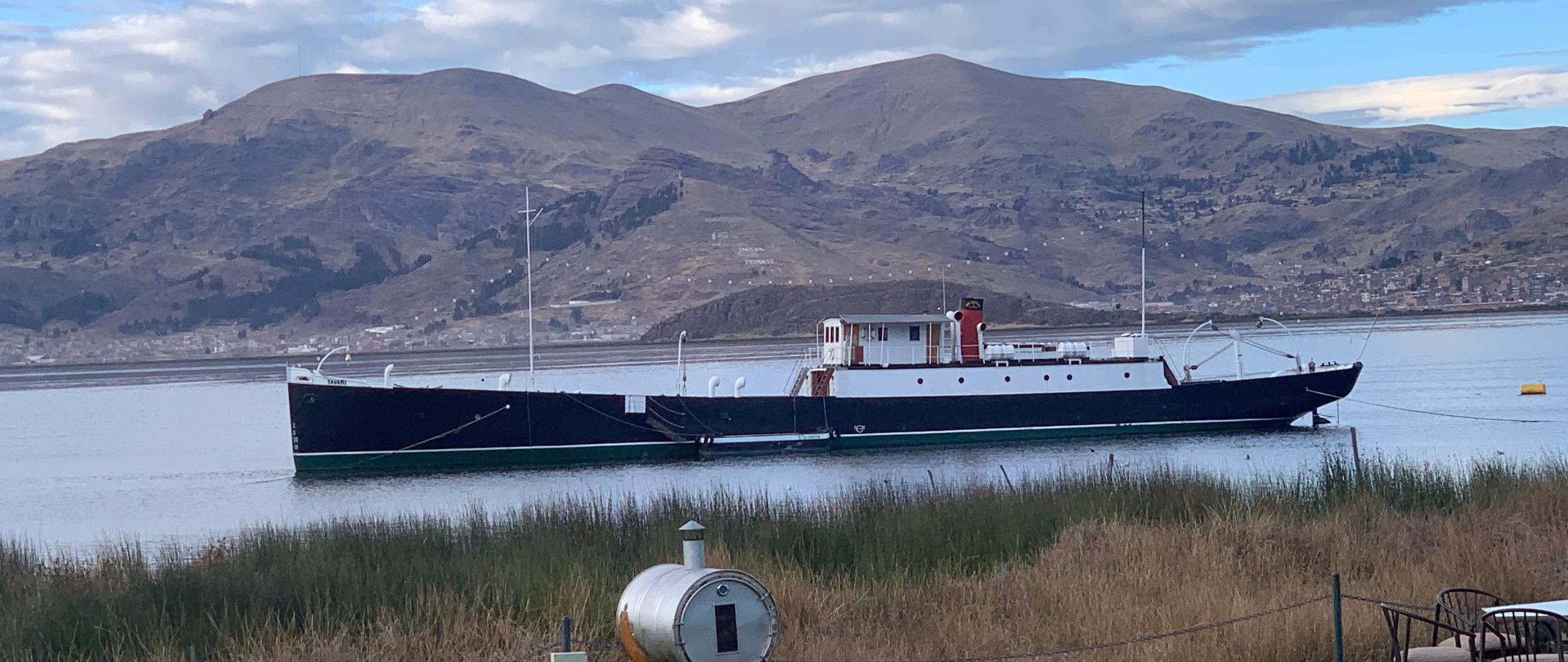
I am writing this in the middle of a heatwave and not having felt any rain for several months. In some parts of the country this has led to canal closures, my home mooring is on the Aylesbury Arm which looks like it has shut for the Summer! We don’t seem to be affected so much by water shortages in our branch area. Gates and paddles being left open are the normal reason for low water.
Canalway Cavalcade has been and gone; much praise must go to the organisers having to deal with the closure of City Road lock due to gate damage and the added closure of Maida Hill Tunnel due to a fire in the sub-station above causing significant pollution in the canal. These events were the cause of a number of boats not getting to the event and boats that did get there having to leave early. However, it was still a great event.

Line-up of boats that did make it to Cavalcade in May
Photo Tim Lewis
Immediately after Cavalcade was the Fund Britain’s Waterways cruise to Westminster when 26 boats left their mooring at Limehouse and proceeded to gather outside the Palace of Westminster and make as much noise as possible to promote our cause for increased spending on our waterways. Most boats returning to moorings at West India Dock and then proceeded upriver the next day. It is the first time that I have ever done the Thames Tideway on a narrowboat three days in succession having got to Limehouse the long way round via Brentford.

The next event in our Branch area is the Angel Canal Festival on 7th September from 11am to 4pm. This is looking to be the biggest one for a while so please try and get there and support it, volunteers to help on the day are always welcome.
Looking at the latest iteration of the 2025/2026 winter stoppage list it would appear that there are no major works planned in our branch area which again would imply that they are in good condition? Lock 1a, Hampstead Road Locks, on the Regent's Canal,experienced a closure for repairs due to a severe failure.The lock had to be dewatered, causing a closure that impacted other nearby locks.The repairs were completed in May, and Hampstead Road Lock 1a, as well as the associated locks (Lock 2 Hawley Lock and Lock 3 Kentish Town Lock), are now open. (See cover photo).
The Branch continues to monitor planning applications that may impact on the Branch area waterways. As has been the case for a while we are seeing a reduced number compared to previous years, most of the large schemes are around the lower River Lea and in Docklands. An interesting one on the Lower Lea is for moorings to be created on the Tidal Bow Creek just above the entrance to Bow Lock, quite an adventurous place to moor I would have thought! Also, in the area permission has been granted on the Bromley-By-Bow gas works site which includes for many of the gasometers to be converted to housing, similar to that carried out canal side at St Pancras and presently being carried out canal side at Haggerston. A planning application has been submitted for housing at Bow Wharf, at the junction of the Hertford Union Canal and the Regents which could lose this site as a wharf. The Travis Perkins site scheme at Little Venice previously refused planning permission by Westminster Council has been called in for review by the Mayor of London. The Camden Lock Ferris Wheel scheme has been ‘paused’ A consultation on Public Realm Improvements to parts of Westminster that include the Rembrandt Gardens and Stone Wharf areas at Little Venice has been commented on.
A stoppage notice has been issued for the installation of a new bridge over the River Lea just south of the North Circular on the Meridian Waters site. In St Pancras the planned footbridge has still to be installed.
In March the London Canal Museum had a visit from their Patron, The Princess Royal, which included the unveiling of their latest temporary exhibition ‘Building Britain’s Canals’ which is on until the end of the year. The Princess was also shown the Museum trip boat ‘Long Tom’ and was introduced to many of the museums volunteers and had a demonstration on ice cream making.
The Branch Annual General Meeting was held in March and the existing committee is the same. Although we do a lot of work between us we would always welcome additional help. Please feel free to contact me should you be interested in helping with the Branch activities.

Date Route Start (Tube Stn.)
20 July Sunday Regent’s Canal: Islington – Kingsland Rd Angel
3 Aug Sunday Regent’s Canal: Kings Cross – Granary Square – St Pancras
Kings Cross, by taxi queue sign, next to outdoor Pret a Manger
17 Aug Sunday Regent’s Canal: Little Venice - Camden Warwick Avenue
24 Aug Sunday Four Hundred Years of the New River Manor House (Finsbury Park Exit, Exit 6)
7 SeptSunday Regent’s Canal: Mile End - Limehouse Mile End
21 Sept Sunday Royal Victoria Dock – East India Dock Royal Victoria DLR (IFS Cloud/ Seagull Lane Exit)
27 Sept Saturday Grand Union Canal: Kensal Green -Little Venice Kensal Green
5 Oct Sunday Regent’s Canal: Kings Cross – Granary Square – St Pancras
Kings Cross, by taxi queue sign, next to outdoor Pret a Manger
19 Oct Sunday Limehouse – Thames - Docklands Westferry DLR (by Cycle Hire Point)
2 Nov Sunday Regent’s Canal: Little Venice - Camden Warwick Avenue
16 Nov Sunday Regent’s Canal: River Tyburn– Little Venice Baker St (Baker St North/ Lords Exit
Start time for all Walks is 2.30 p.m.
Rates: Normal charge: £20
Seniors (65+) and Students rate: £15
Children aged 16 and over, accompanied by parents: £15
Children aged 8 – 15, accompanied by parents: £5
(Children under 8, accompanied by parents, go for free)
Walkabout Card: These cards are available for both adults, seniors, students and children aged 16 and over accompanied by parents. They cost £5 to buy and then give £5 off every other walk taken. The cards are valid for 6 months.
Prior booking is strongly recommended: Please contact London Walks: 020 7624 3978. Or email - london@walks.com.
It is possible to check the IWA website (waterways.org.uk), or the London Walks website (walks.com) to see if any late changes to the walk have had to be made.
I'm writing my input for your branch magazine on my way back from the Market Harborough 75 Rally of boats. The event, held at Foxton Locks, was to celebrate 75 years of campaigning since the first major campaigning event, held by the, then, fledgling IWA at Market Harborough in 1950. The event got me thinking about how the founders of the association would be amazed at the changes that had happened to the waterways since then. They would obviously be saddened by the loss of the longdistance traffic, that used to carry coal across the country. However, I think they would be astounded at how much their Association had achieved in the years since the first rally.
Our association has led a waterways movement that has reopened major canals like the South Stratford and the Huddersfield Narrow Canal, to name but two, has seen the condition of much of the rest of the network improved to a standard they could not have imagined. However, in my opinion, the greatest achievement has been the change of the public perception of the waterways. In 1950, most people, if they thought about the canals at all, would consider them to be dirty, dangerous places and not somewhere you visited. Indeed, in London, they were locked away behind steel gates so no one could get onto the towpath. The work of our association has meant that these days people value the canals and use them regularly for leisure, boating of course, but cycling, walking, and fishing. Today they are blue-green corridors reaching into the heart of our cities valued by people of all ages.
Once again, the waterways network and all the efforts of our association over the last 78 years is at risk. Global warming is putting strains on the network that no one could have imagined 75 years ago. Extreme weather events such as heavy rainfall and drought are coming more common and are causing parts of the network to collapse! In some ways, our success in making the canals a place for everyone to enjoy, is also part of the problem. For many people, the canals are so much a part of their everyday lives, and “they” will make certain they are available for them to enjoy just like the NHS. They don't think about the cost of maintaining a network which is now over 200 years old and was designed at a time when labour was cheap.
Our association has been leading the waterways movement with the Fund Britain’s Waterways campaign, but this is running to its end and will soon need to have a new focus. What can we do now? Our association needs to show how the boating can be sustainable, how freight can be brought back to the waterways to reduce carbon emissions from road transport and help in transferring water from wetter parts of the country to the drier parts.
How can you help? We need more money and members to carry out these campaigns and give us credit with government at all levels. Many younger people don’t have the time to actively support our campaigning, but could they afford less than £5 a month to support our cause? That’s all our membership costs. Why not tell them about the work of their parents and grandparents’ generations, in saving our waterway network and see if they could help by becoming a member or giving a regular donation.
Paul Strudwick
London Region Chairperson
Email Paul.strudwick@waterways.org.uk
Tel: 07885 240291
I hope you are all having a good summer and enjoying the good weather we have been having with plenty of boating and/or other holidays. I have just had a weekend helping lead 34 boats on the tidal Thames on our annual St Pancras Cruising Club (SPCC) tideway weekend. Panacea was leading one of the lockings down river from Limehouse in the early hours of Saturday 28th June through the barrier and to Margaretness, near the entrance to Barking Creek. We then waited for the tide to turn and Panacea, being one of the lightest boats, had a challenging time with the wind.
As we came back up-river we were joined by a further group coming out of Limehouse who wanted to just do the Limehouse to Teddington or Brentford run. Our group were all heading for Teddington and 6 of the boats would be returning downstream from there in the very early hours of Sunday 29th. We moored up on the pontoon on the outside of the lock island whilst the other 12 boats who were travelling on headed into the lock. Unfortunately, there was an obstruction in the bottom gates so, despite every effort to shift it, the boats had to back out again. We were then 18 boats on the pontoon instead of 6!
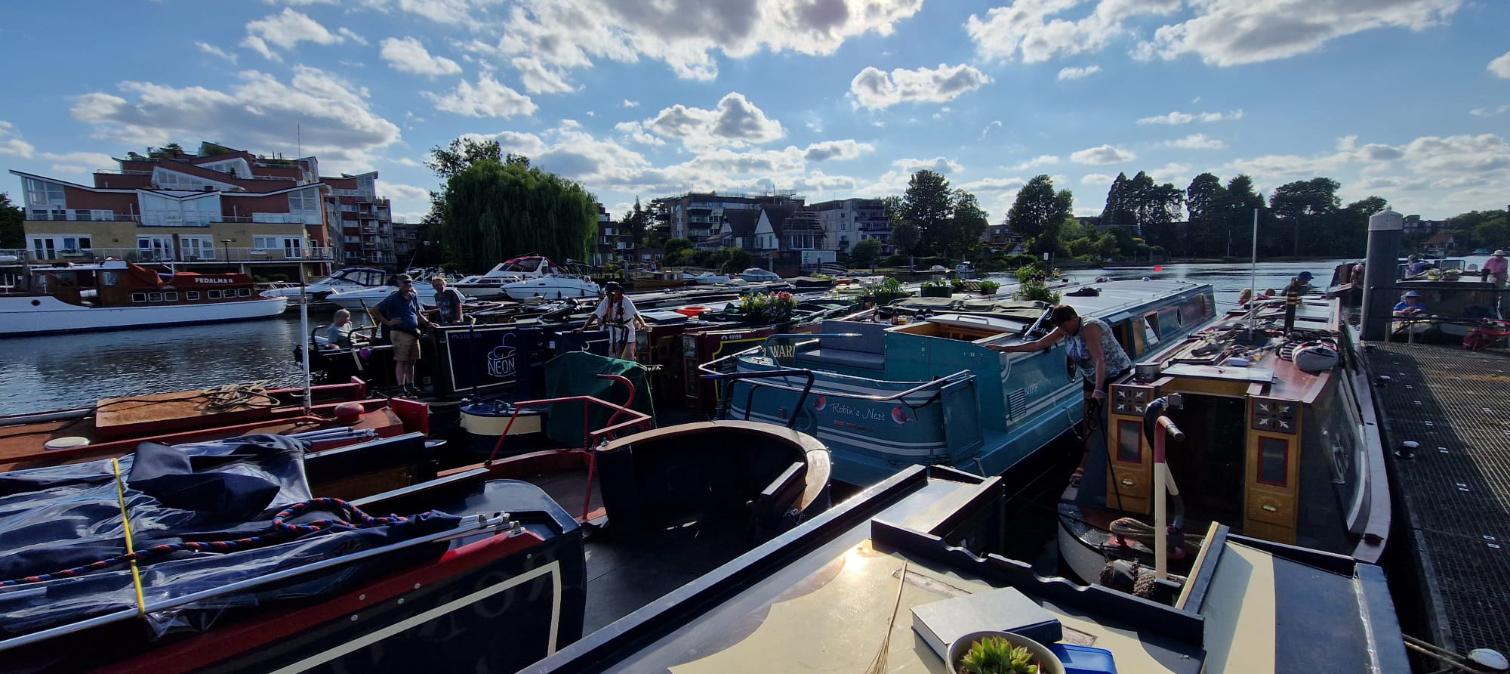
Pontoon
4.30am – yes really! – saw Panacea lead the 6 boats on the downstream run, at first with the tide still coming in. The boats who had stayed overnight at Brentford came out an hour later and we were all safely back in Limehouse before 9.30, just in time before the lock closed again until the next tide. This is a great way to introduce people to safe passage on the Tidal Thames which, of course, is in our branch area.
We had decided to hold our East Croydon socials on alternate months due to the lower attendance recently and not wishing speakers to have low numbers. We held our AGM in April where Dorothy Robbie was re-elected to the committee having completed her 3 years and Ian Sesnan was elected having been co-opted last year. Below is much of my report for the AGM omitting information that has been covered in previous editions of Meridian Cuttings, also with an update on Branch stand activities that have taken place since April.
We have continued to take our branch stand to Waterway events and so far this year have been to Canalway Cavalcade in May, Brentford Festival in June and a new nonwaterway event, in our branch area, at Culverley Park Catford by invitation of Bob and Mary Metcalf. We are keen to find more events in South London so, if you know of anything in your area, please get in touch with me or one of the committee members. We continue to receive donations of Waterway books and now have all Allan Scott’s and Judith Hunter’s. We sell these at events and branch social meetings. Our thanks to Eric Garland who is able to price these appropriately.
All offers of help with events are gratefully received. My thanks to all who helped last year - Eric Garland, Bob and Karen Hansen, Bob & Mary Metcalf, Ian Sesnan, Lesley and Gerard Pryde-Coales, Dorothy Robbie and Shea Richardson. Also, thanks to Michelle Griffiths for help setting up and clearing away each day at Canalway Cavalcade; and to George and Sandy Goodwin who kindly store the branch stand and its kit.
Although South London Branch has no navigable canals, we have the tidal River Thames and all tributaries south of the river. The Thames is a vibrant river with plenty of activity. The Port of London Authority (PLA) has a 2050 vision which looks at 3 priorities – Trading Thames which aims for net zero and good infrastructure for ongoing movement of freight, Destination Thames promoting accessible and safe Leisure use and Natural Thames promoting clean air, water, and land. As reported previously, their most recent publication was Priority Action Plan for a Clean Thames (2024-2030). As previously described, I quote: “Our 2050 Vision is of a clean river, free of sewage, waste and other pollution, supporting greater biodiversity and recreational use”. Details on these priorities may be found in the full document on the PLA website: https://pla.co.uk/sites/default/files/2024-04/CleanThames-Plan.pdf
Clean-ups on the river continue to be a vital part of this work many of which are organised by Thames21. Battersea Beach Clean events take place on Saturdays at different times, dependent on tides at the slipway by St Mary’s Church, SW11 3NA.
Here are the dates for the next few months:
Saturday, 19 July at 2.30pm (finishes 4.30pm)
Saturday, 26 July at 10am (finishes 12pm)
Sunday, 17 August at 2.30pm (finishes 4.30pm)
Saturday, 30 August at 12.30pm (finishes 2.30pm)
Saturday, 13 September at 12.30pm (finishes 2.30pm)
Saturday, 27 September at 11.30am (finishes 1.30pm)
These are organised by Samantha Johnson – please contact her if you would like to take part: batterseabeachclean@gmail.com
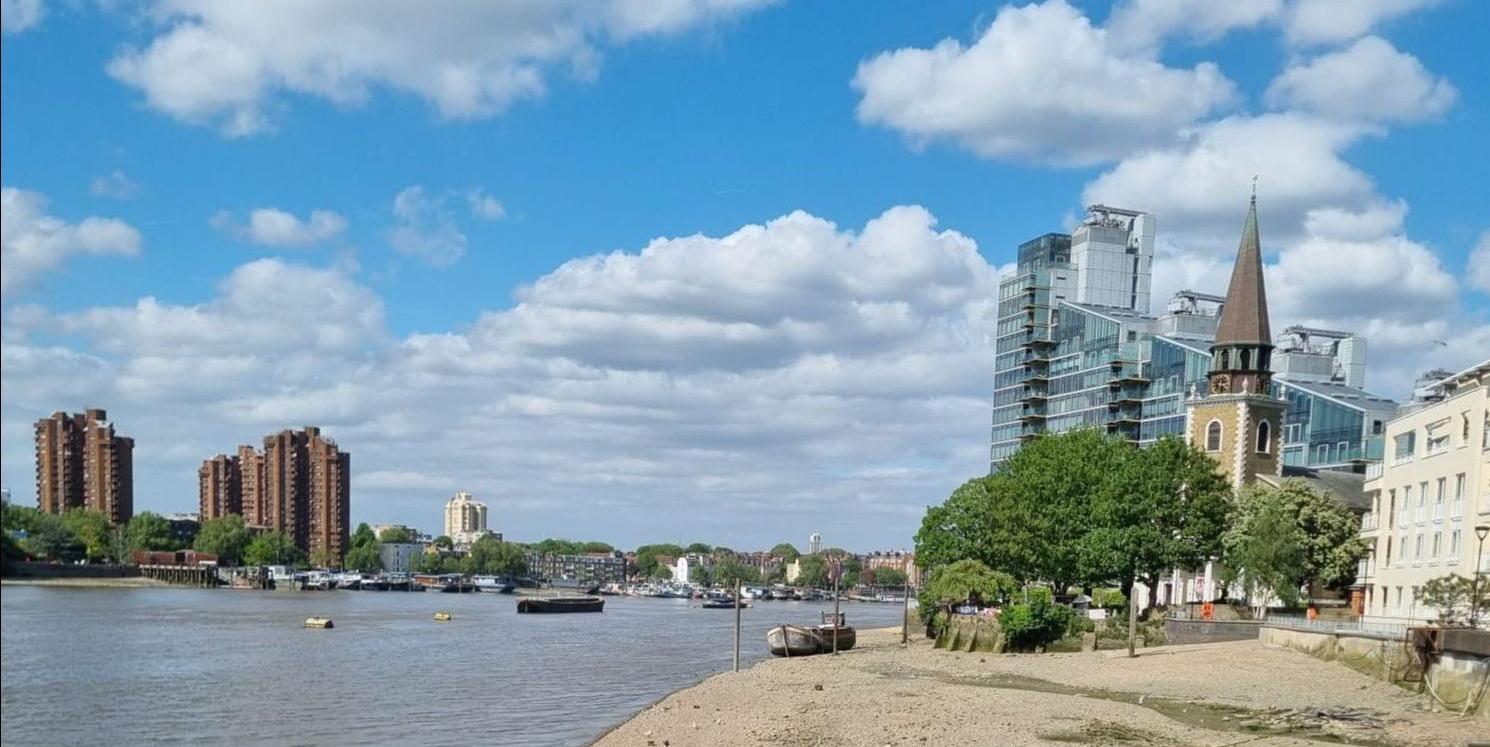
PLA hold meetings with stakeholders and Ian kindly attended the Thames Leisure Group one recently on behalf of the branch. Another group is ‘Your Tidal Thames Catchment Partnership’ which meets twice a year. This is a collaborative partnership of organisations along the Thames from Teddington to the sea co-hosted by Thames21 and the Thames Estuary Partnership (TEP). Either Simon or I usually attend these meetings
Lifeboats on the Thames – As most of you know, I am heavily involved with Lifeboats and last year we celebrated the 200th anniversary of the founding of the RNLI. This year we are seeing good progress on the development of a new station on the Thames at Wandsworth Riverside. This will replace the station at Chiswick in 2026 and is much better positioned on the river than the Chiswick station as 70% of the call outs at Chiswick are down river from there. I wrote an article in the last Meridian Cuttings on this so will just add a couple of things. I am involved in the fundraising project group for the new station, and we are planning a number of events this year including a Trafalgar night dinner in October. Prevention is key to the work of the RNLI and water safety guidance, well maintained equipment, including lifejackets, are an essential part of education. Sadly, a huge percentage of rescues on the River Thames are due to mental health problems.

As you will know, we are potentially in crisis over funding for the future of our Waterways. Last May ‘Panacea’ and Chedoona joined the Campaign Cruise for ‘Fund Britain’s Waterways’ (FBW) on the River Thames, cruising to the Palace of Westminster, on Wednesday 8th May. I had hoped ‘Panacea’ would be taking part again this year on Wednesday 7th May as had Bob and Mary Metcalf on Chedoona but, unfortunately, we were all unable to do this. Boats have been coming down from all over the country and it was another successful event though, being at the same time as the VE day celebrations, did not get the publicity it deserved.
Our IWA Canalway Cavalcade weekend took place the previous weekend beset with problems due to, firstly, a closure at City Road Lock and then the closure of Maida Hill tunnel due to the pollution from the fire at the nearby substation. A full report on the event was not available for this edition but we hope will be published later.
Wishing you all a happy summer!
Libby
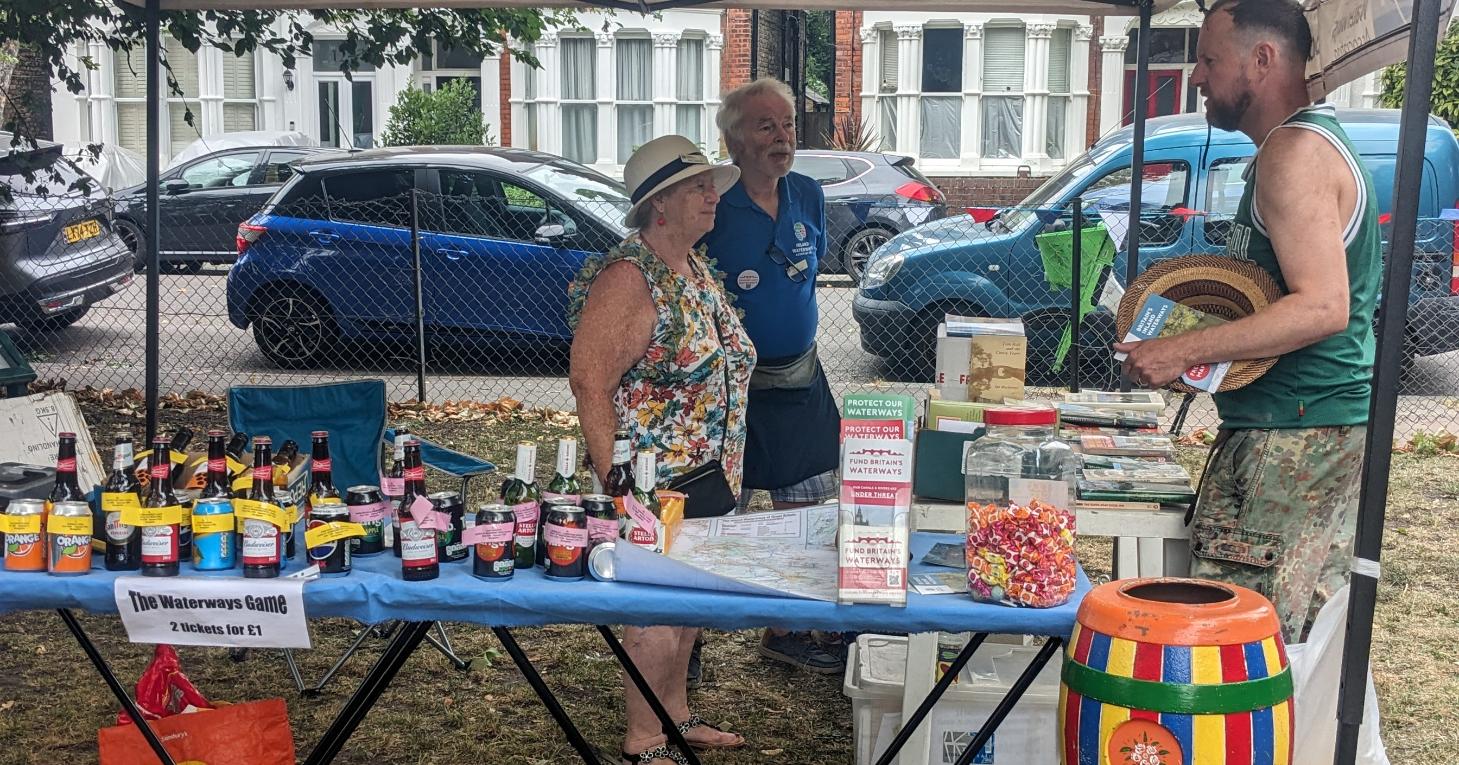
Our stand at the Catford event, taken by me, with Mary Metcalf and Eric Garland serving
SAVE THE DATE! Sunday 7th September 2025
11am- 4pm
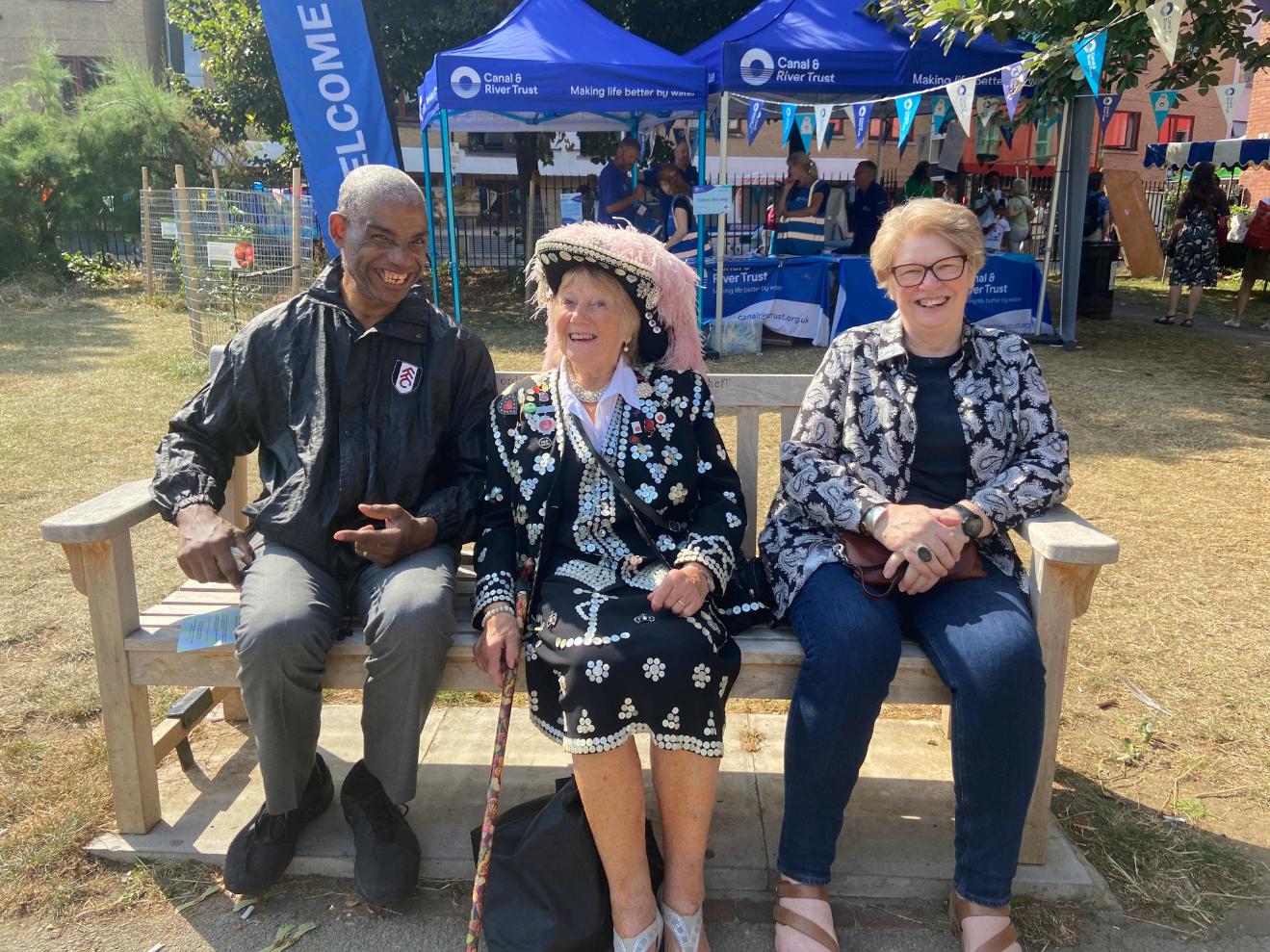
This year’s ever popular free community fest ival take place with all the family favourites:- Punchand Judy Morris
Dancing Live Music Juggling Have-a-go canoeing Craft Market
Art Activities Pearly Kings and Queens Boat Trips and much more! (Great street food too).
Join your neighbours and boating friends for a fun day out.
Contact:- sasha.keir@btinternet to find out more.
Also our website:- https://www.angelcanalfest ival.co.uk
Stalls hire: £50. Catering pitches £110.
And we are always looking for more volunteers to help out!
Environmental charity Thames21 and the River Roding Trust are working together on a groundbreaking programme to identify, test and fix the most damaging sewage and road run-off outfalls on a ten-mile stretch of the River Roding – London’s third biggest river.
This section of the Roding is impacted by more than a hundred outfalls that have the potential to feed pollution from road run off, misconnected properties and combined sewers into the river.
Chris Coode, CEO at Thames21, said: “Improving water quality and restoring the health of our rivers is essential. That’s why we’re proud to be working together with communities, the River Roding Trust, and other partners to tackle pollution in this precious river. This project will identify the most polluting outfalls and recommend targeted solutions to address them. It will also establish a baseline for water quality by monitoring key indicators such as phosphates, ammonia, bacteria, and road runoff.”
The River Roding Trust will conduct weekly monitoring with real-time monitoring devices. Meanwhile, Thames21 will be analysing the results and working closely with Thames Water and local authorities to identify and implement practical solutions to the most polluting outfalls. Through the combined efforts of this project, the partnership group aims to deliver much-needed, effective improvements to the poor water quality currently affecting the Roding.
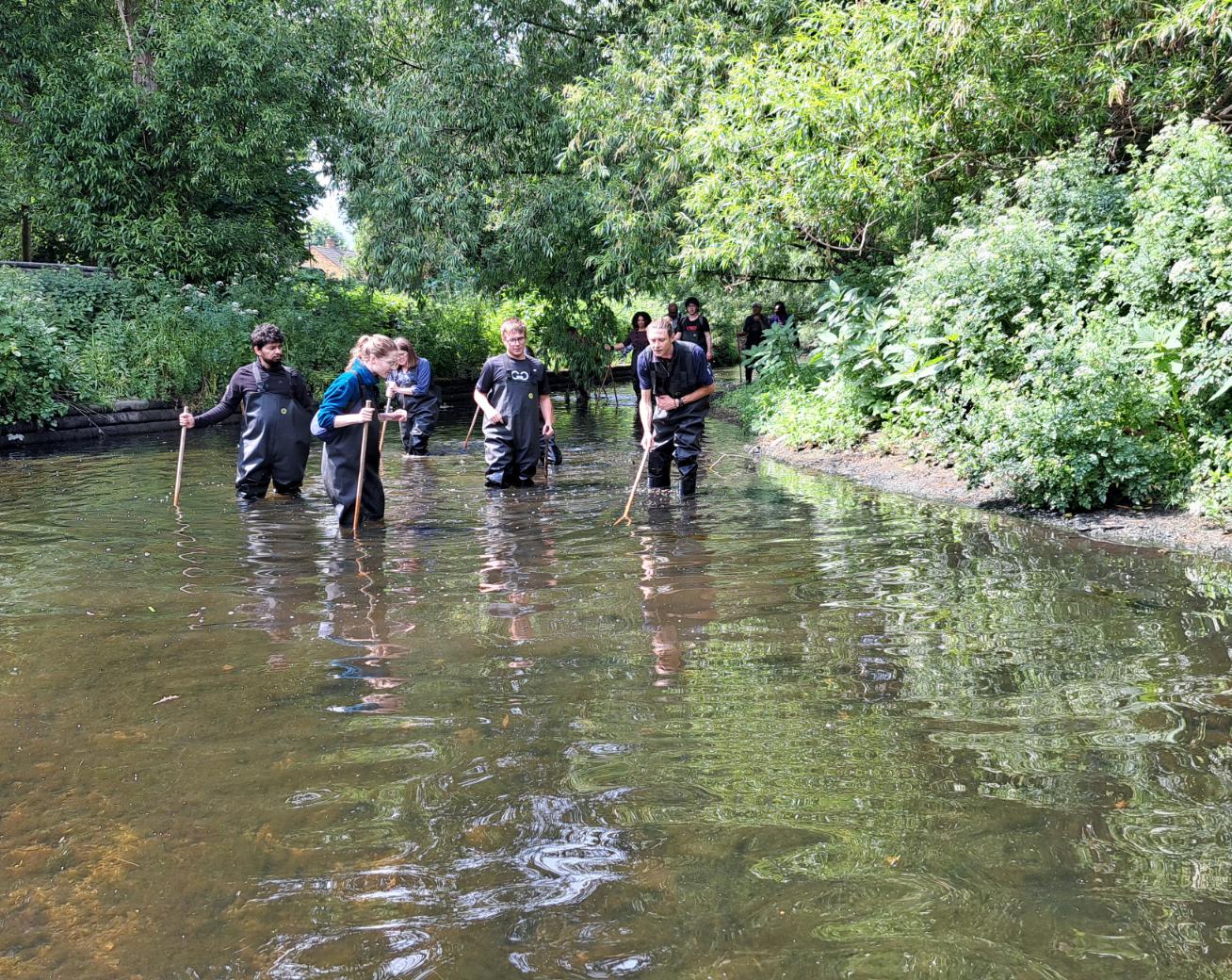
This comprehensive monitoring programme, supported through Thames Water’s Catchment Partnership support fund, is an example of how local NGOs, working withinThe Catchment Partnershipframework, can drive positive improvements to London’s rivers.
Coode added: “If you’d like to get involved in citizen science water quality monitoring and live in east London, then come along to our free AquaTracker training event on Saturday 9th August. You’ll learn about river pollution, and how to monitor the water quality of waterways in the Roding, Beam and Ingrebourne catchment.
Use https://book.plinth.org.uk/e/zP91DyUHooh08GbpgAzWto sign up.
The editor and his wife joined a London Rivers Week walk organized by West London Ramblers, the Brent River and Canal Society and their action group CURB (Clean Up the River Brent). The walk started at Boston Manor station but within 5 minutes we were in the Wellmeadow nature reserve which led us down to the Grand Union Canal which, above that point, is part of the River Brent which then leaves the canal via a large weir above Osterley lock. I took the photo right of a continuous cruisers’ boat on the canal/ river at this point.


The River Brent joins the canal just below the bottom Hanwell lock, lock 96. The Brent River path leaves the canal towpath between locks 96 and 97. The towpath and the Brent footpath here form part of the Capital ring long-distance path. The leaders of the walk stopped at many points to tell about the work done by CURB volunteers to monitor and improve its water quality and protect and enhance the biodiversity of meadow, woodland and wetland habitats along its banks. The importance of clearing invasive plants, such as Himalayan Balsam, and of other invasive species was highlighted, though the main invasive species we saw were Lime bikes. I photographed four in the river.
The walk was inspiring for the dedication of the organisers and signs of progress in improving the river in places but depressing in the clear signs of sewage entering the river from misconnected drainage.

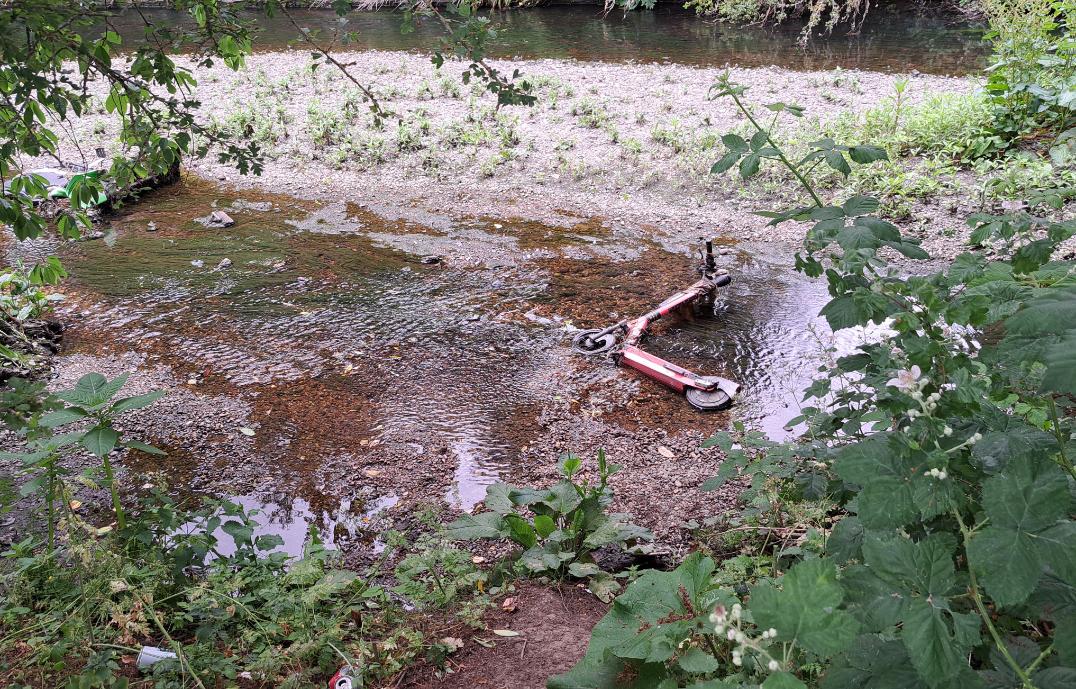
At our June social we discussed having some alternative activities to talks as the latter have not been very well attended recently and do not justify the cost of the room. We therefore have no forthcoming dates planned at East Croydon and are looking at other options. All ideas welcome.
We plan to organise some social outings, including a trip on the river Thames, a visit to a Lifeboat station on the Thames and a visit to Kew Bridge Engines, near Brentford, when they are in steam. The proposed date for this visit is Sunday 23rd November. The engines are in steam from 10am – 4pm and the group rate will be between £12.50 per person and £18 per person depending on whether or not we choose to have a guided tour.
“The London Museum of Water & Steam is a unique place for group visits. Explore the world's largest collection of stationary steam engines and discover the role the Kew Bridge Waterworks played in making London the great city it is today.The exhibits comprise the Cornish engines, which are in their original engine houses, and the rotative engines, which have been collected by the museum trust from pumping stations across the country”.
For further information see https://waterandsteam.org.uk/
Please contact Libby ASAP at libby.bradshaw@ursa.me.uk or on 07956 655037 if you would like to be included in this Group Visit, or just to express an interest if you re not yet sure.

The focus of Lee & Stort Branch’s activities in recent years has been organising the Ware Boat Festival, run as an integral part of Ware Festival throughout July each year. Last year the boat festival had to be cancelled at very short notice because Hertfordshire County Council suddenly decided that towpath (which is a designated Public Right Of Way) was made unsafe by the presence of a few tree roots breaking the surface. This year, however, we had no last-minute hiccups and the festival run to everyone’s enjoyment over the weekend of 4th – 6th July. For a variety of reasons several of the team that has organised the boat festival over many years stood down but fortunately a number of other non-IWA members stepped up to the plate and allowed the event to proceed.
Something which had the potential to put a blot on the whole event, but which –thanks to the good nature of those boaters who attended – was C&RT’s unwillingness to enforce their official Mooring Suspension. As a branch committee we are determined to take this forward, although how we do so is under consideration, because our continuation of organising this local event is wholly dependent on achieving some guarantee of the Trust’s proper support.
Otherwise, as Garrison Keillor might say, “It has been a quiet time on the Lee & Stort …”
Mike Newman
Chairman, Lee & Stort Branch
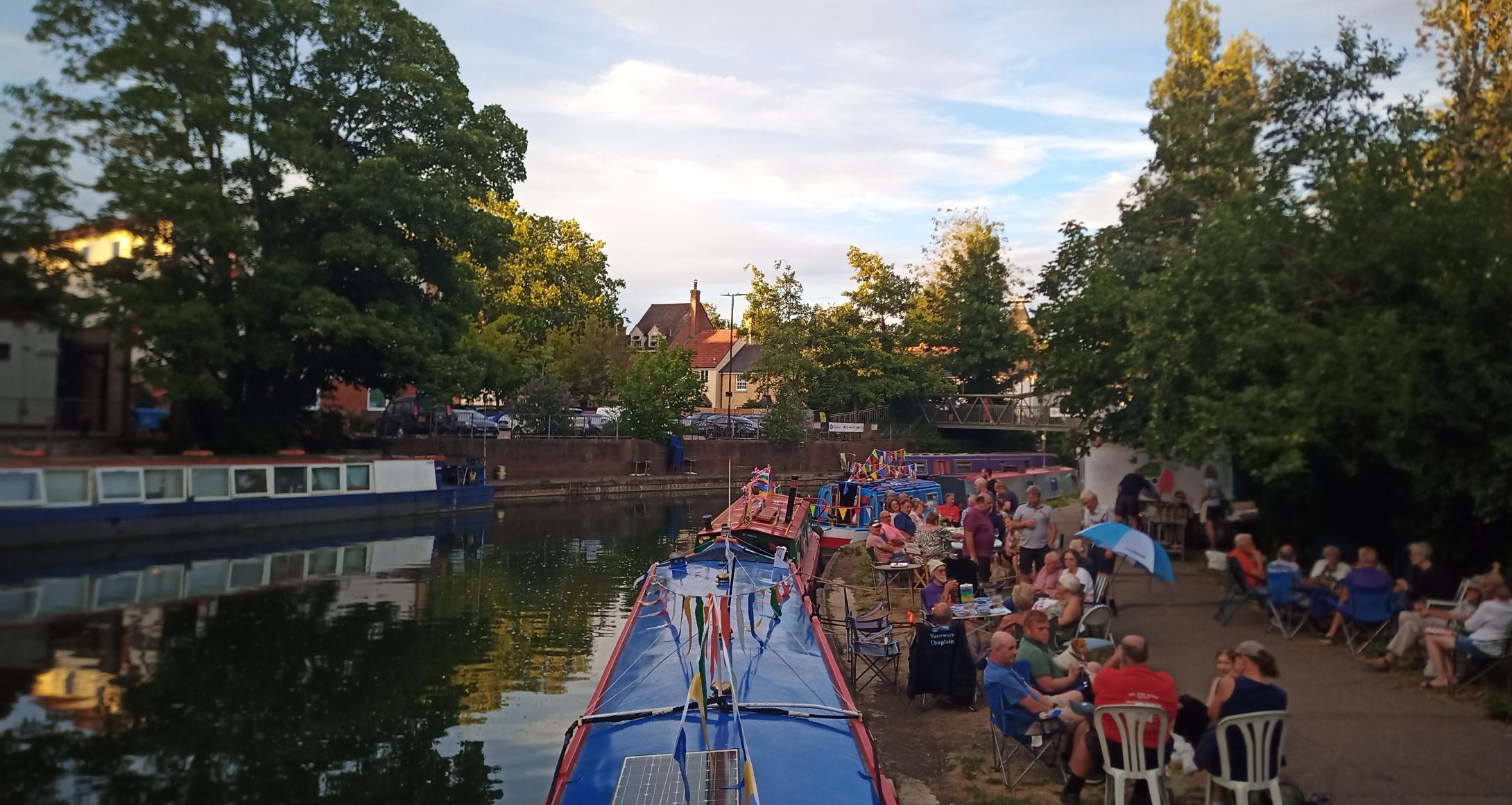
I regret that we have been unable to obtain a full report of Cavalcade, however we have been informed that, despite the difficulties many had trying to get their boats to the site, the event was a great success. The photos below and overleaf were taken by Tim Lewis.
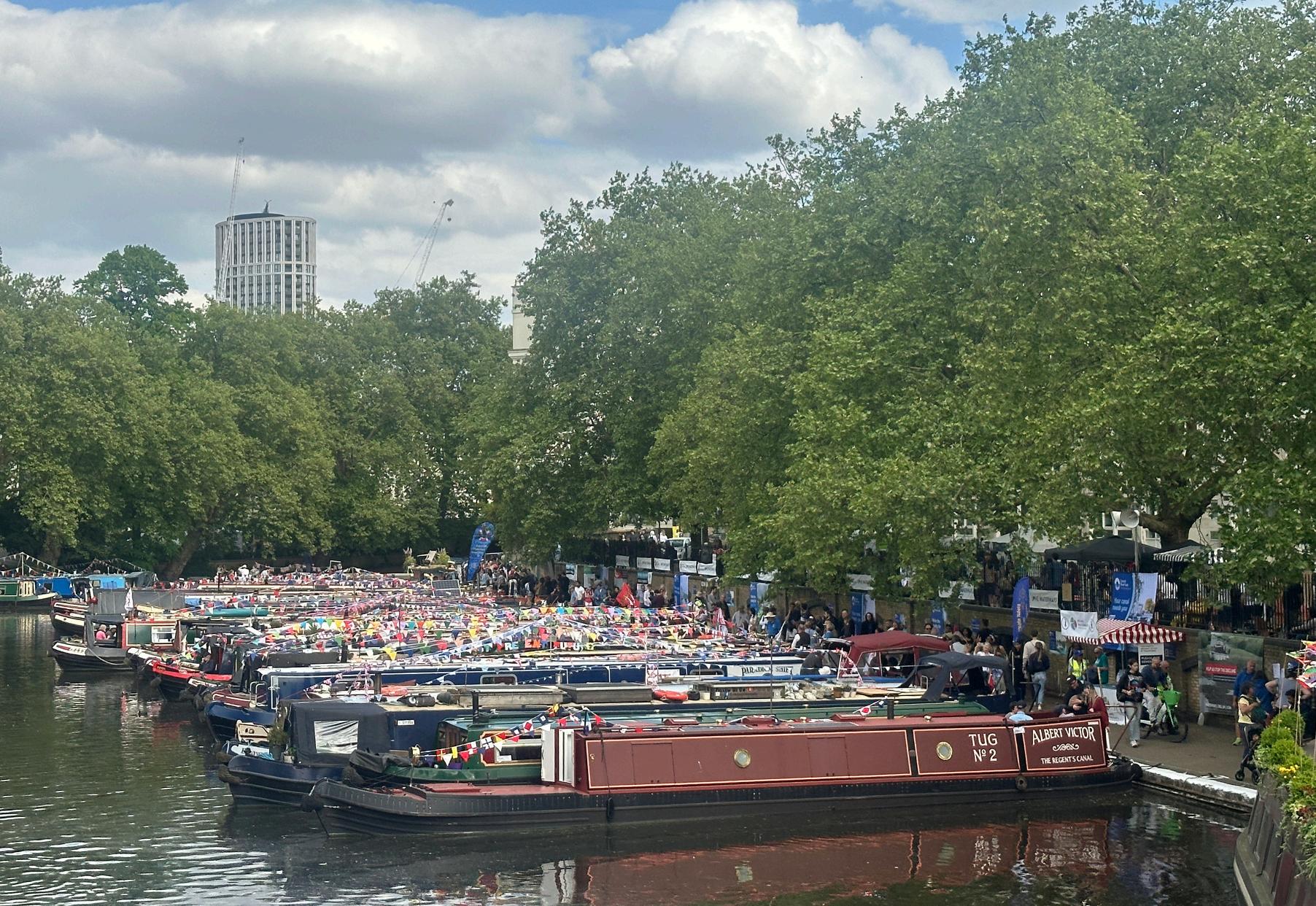


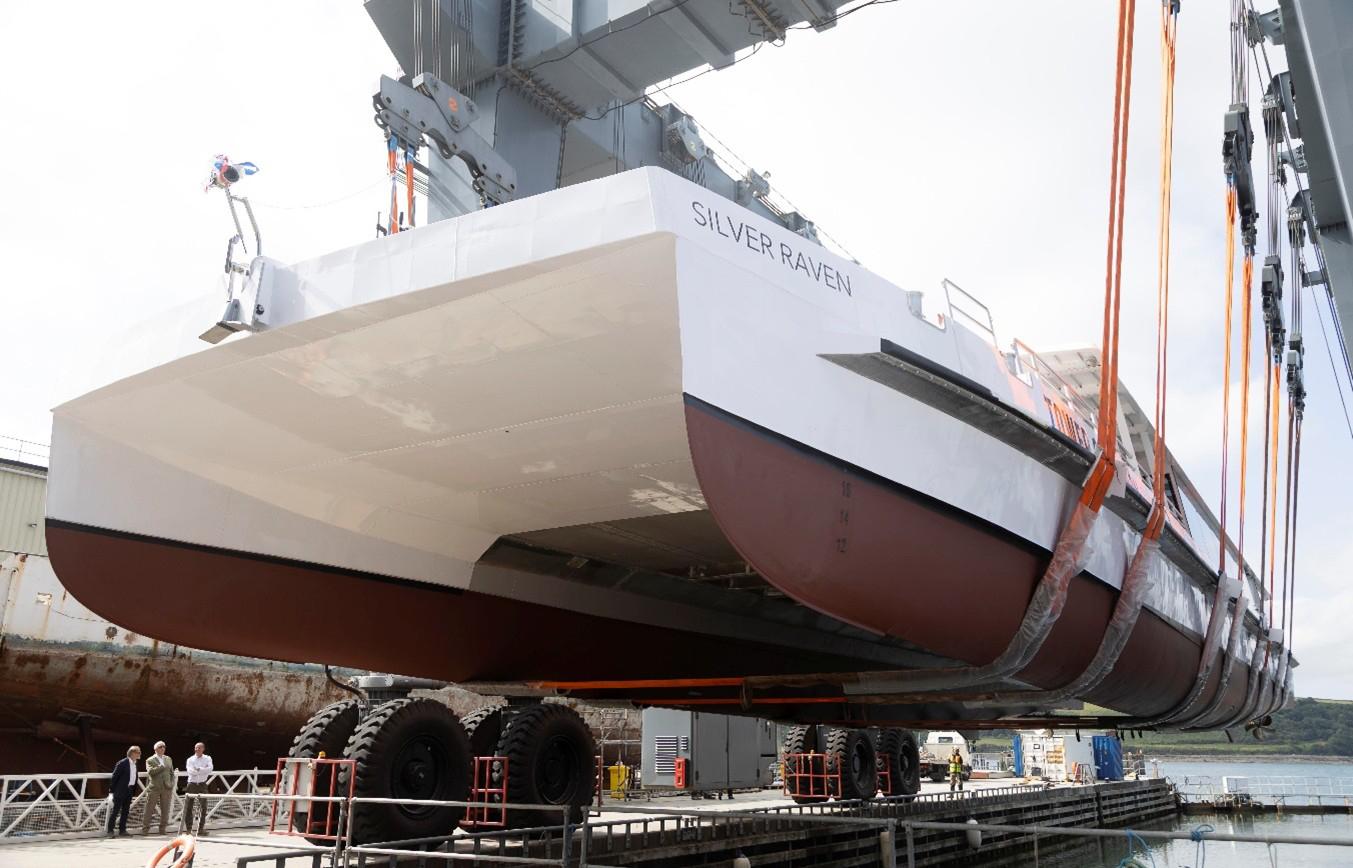
The UKs first electric tour boat, named the Silver Raven to celebrate her full time role partnering the Tower of London, has entered the water at Pendennis shipyard in Cornwall. The Tower of London River Tour tickets also went on sale for midSeptember dates via the dedicated website www.toweroflondonrivertour.co.uk
The aluminium Tower of London River Tour vessel design draws from a huge breadth of experience and history to launch the new Woods Tours brand developing a world-leading, all-electric luxury sightseeing fleet.
Silver Raven's design and power profiling is by Vulkan Marine, with an EST Floattech Octopus Series battery bank which will be rapid-charged between each tour from a two-megawatt shore charging facility (sustainable energy sources).
The attention to detail will be apparent throughout the vessel’s design from clean, contemporary lines echoing the heyday of Thames River cruising during the 1920s and 30s with wide, awning-shaded decks, single deck panoramic views, bespoke wool woven carpet from Devon's Axminster looms and Scottish leather seating.
Following the driest spring since 1893 and continued hot sunny weather, with parts of England already officially in drought, the Canal & River Trust is advising that water availability across some parts of the canal network is under strain with low river flows and reducing water holdings in the charity’s canal-feeding reservoirs.
Whilst the majority of the network is open and fully navigable, there are currently restrictions in place on certain canals. Mostly, this means reduced lock operating hours, which are intended to extend water supplies and navigation for as long as possible this summer. In some instances, low water supply means that boat passage through locks has been temporarily suspended. A map of the affected areas can be found on the Notices section of the Trust’s website. While navigation restrictions currently mostly affect northern waterways, the continued dry weather means that restricted lock opening times are now being introduced elsewhere, including sections of the Grand Union and Oxford canals, and in some parts of the midlands.
Alex Hennessey, national boating manager at Canal & River Trust, said: “The conditions we’ve seen so far this year are putting pressure on the water supplies needed to facilitate navigation. The lack of rainfall is the primary driver for low flows and, in some areas, this is compounded by essential reservoir repairs required by legislation, which are temporarily reducing their water storage capacity. In addition, the Trust is now required to comply with modern legally binding environmental conditions in place to protect rivers and streams which can limit the feed of water into the canal network, further reducing historic sources of water. The canal network has a constant demand for water. Whilst boat passage through locks is an obvious use of water, evaporation and transpiration can see canals lose as much as an inch of water on hot summer days. An underlying ‘sweetening flow’ is also always needed to support ecology and avoid canals turning stagnant.”
The Trust’s volunteer lock keepers have been helping to manage boat traffic at lock flights to ensure water supplies are used as sparingly as possible, and the Trust continues its programme of water saving repair works to increase all available water flows into the canal network. Water levels are being reviewed on a daily basis and the Trust will remove, or introduce, water saving measures as necessary. If it rains enough to allow safe navigation, restrictions will be lifted immediately: this is likely to require sufficient and prolonged rain over several weeks rather than a sudden very heavy downpour.

Chris Bushill
Alex continues: “We know how frustrating navigation restrictions are. We’re grateful to boaters for their support and patience, including those with deeper draughted vessels. We’re asking everyone to be extra vigilant this summer; sharing locks wherever possible, double-checking that paddles are fully closed, and planning routes carefully. These all make a real difference in helping conserve water and sustaining navigation for everyone.”
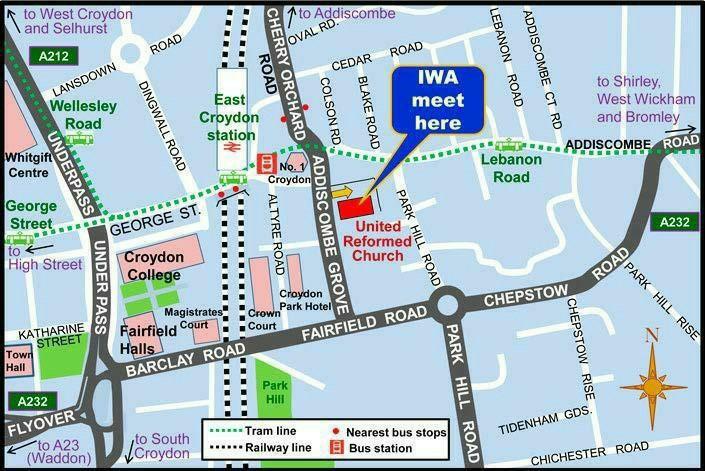
IWA South London Branch, United ReformedChurch, Croydon
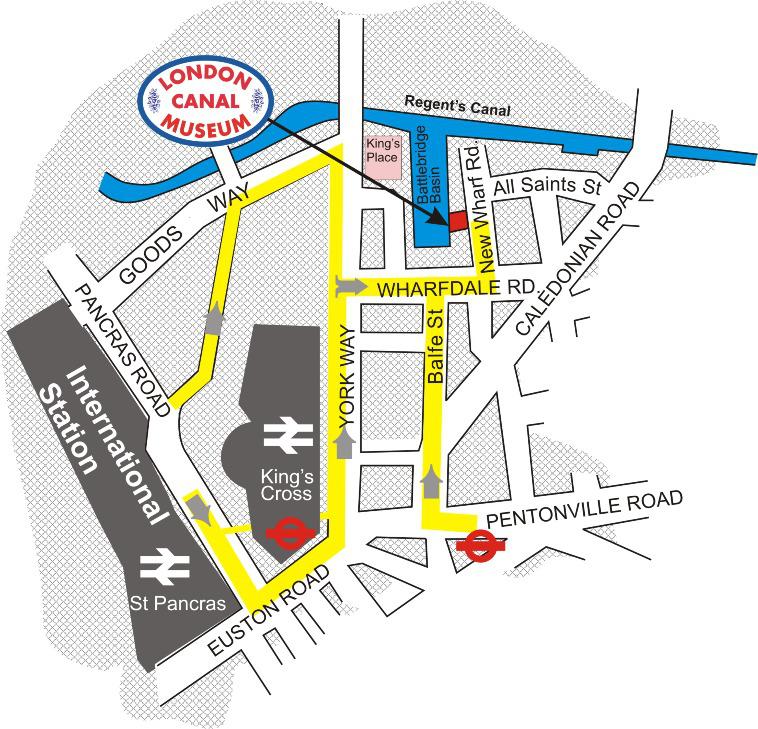
London Canal Museum, New Wharf Road, N1 9RT
Chairman
Tim Lewis Tel: 02085300425 / 07802518094 tim.lewis@waterways.org.uk
Secretary Tim Lewis
Treasurer
Ian Israel Tel: 020 84461823 ian.israel@waterways.org.uk
Social Secretary Vacancy
Libby Bradshaw Tel: 07956 655037 libby.bradshaw@waterways.org.uk
Simon Dyer Tel: 07857 978111 simondyer@outlook.com
Dorothy Robbie Tel: 02088576367 dorothy.robbie@waterways.org.uk
Shea Richardson, Tel: 02086770196 / 07803904803 shea.richardson@homecall.co.uk
Minutes Secretary Chris Bushill Vacancy
Newsletter Editor
Chris Bushill Tel: 02082457063 chrisbushill@hotmail.com
Membership Secretary Liz Rayner lizrayner48@gmail.com
Publicity Officer Vacancy
Rod Gray rodgray125@aol.com
Planning Officer
London Walks Representative Roger Wilkinson –Tel: 02036129624 roger.wilkinson@waterways.org.uk
Committee Member
Ex-Officio as Region Chairman
South London Representatives Planning & Conservation Committee: Wandle Valley developments
Corresponding Member
Lee and Stort Chairman
Dorothy Robbie Tel: 02088576367 dorothy.robbie@waterways.org.uk
Lesley Pryde-Coales lesley.pryde@waterways.org.uk
Simon Dyer Tel: 07857 978111 simondyer@outlook.com
Ian.Sesnan Tel: 07971 528207 Ian.Sesnan@waterways.org.uk
Paul Strudwick Tel: 01248535342 / 07885240291
Eric Garland, Simon Dyer, Shea Richardson
Derek Humphries derek.humphries@waterways.org.uk
Mike Newman Tel. 07887 540398 mike.newman@waterways.org.uk
If you feel you could help with any of the vacancies or would be interested in joining us as an ordinary member we would love to hear from you
